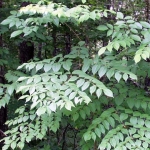| Common Name: |
Yellow Wood |
| Other Names: |
Northern Prickly Ash, Prickly Ash, Southern Prickly Ash, Toothache Tree |
| Botanical Name: |
Zanthoxylum americanum (northern), Zanthoxylum clavoherculus (southern) |
| Genus: |
Zanthoxylum |
| Family: |
Rutaceae |
| Native Location: |
Worldwide |
| Cultivation: |
Fertile soil in sun or shade. Remove dead wood (which is prone to coral spot fungus) and cut back in late winter or early spring. |
| Propagation: |
By seed sown in autumn; by root cuttings in late winter. |
| Harvest: |
Leaves (Z. piperitum) are picked during the growing season and used fresh. Bark is stripped in spring and dried for use in decoctions, liquid extracts, and tinctures. Fruits are collected in summer and dried for use in decoctions and liquid extracts. |
| Height: |
4-8m (12-25ft) |
| Width: |
6m (20ft) |
| Hardiness: |
Z4-8 |
| Parts Used: |
Bark, Fruits, root bark, berry |
| Chemical Constituents: |
Acid amide
Asarinin
Berberine
Herculin
Xanthoxyletin
Xanthyletin
|
| Known Effects: |
Stimulates and irritates gastrointestinal tract
Increases perspiration
|
| Possible Additional Effects: |
May stimulate appetite
May treat arthritis
May decrease flatulence
|
| Properties: |
A spicy, warming, stimulant herb that relieves pain, lowers fever, stimulates the circulation, improves digestion, controls diarrhea, and is anti-rheumatic. |
| Medicinal Uses: |
Internally for rheumatic and arthritic complaints, lumbago, toothache, fevers, peripheral circulatory problems, abdominal chills, diarrhea, indigestion, and chronic skin conditions. Externally for chronic joint pain and rheumatism. Combined with Myrica cerifera (See, Bayberry) and Zingiber officinale (See, Ginger) for circulatory insufficiency; with Actaea racemosa (See, Black Cohosh) for tinnitus; and with Capsicum annuum (See, Sweet Bell Pepper), Guaiacum officinale (See, Guaiac), and Menyanthes trifoliata (See, Bog Bean) for rheumatic complaints.
To treat blood pressure, fever, inflammation, rheumatic disorders, and gastrointestinal ailments. |
| Typical Dose: |
A typical dose of northern prickly ash in tincture form is approximately 5 ml (1:5 dilution in 45 percent alcohol), taken three times daily. |
| Possible Side Effects: |
Northern prickly ash's side effects include nausea, vomiting, hypotension (low blood pressure), allergic reactions, and photosensitivity (skin sensitivity to sunlight). |
| Adverse Reactions, Side Effects, or Overdose Symptoms |
| Signs and Symptoms |
What to Do |
|
| Diarrhea |
Discontinue. Call doctor immediately. |
| Nausea or Vomiting |
Discontinue. Call doctor immediately. |
|
| Drug Interactions: |
| Taking northern prickly ash with these drugs may increase the risk of bleeding and bruising: |
| Aminosalicylic Acid, (Nemasol Sodium, Paser) |
Antithrombin III, (Thrombate III) |
Argatroban, (Argatroban) |
Aspirin, (Bufferin, Ecotrin) |
| Bivalirudin, (Angiomax) |
Choline Magnesium Trisalicylate, (Trilisate) |
Choline Salicylate, (Teejel) |
Dalteparin, (Fragmin) |
| Danaparoid, (Orgaran) |
Enoxaparin, (Lovenox) |
Fondaparinux, (Arixtra) |
Heparin, (Hepalean, Hep-Lock) |
| Lepirudin, (Refludan) |
Salsalate, (Amgesic, Salflex) |
Tinzaparin, (Innohep) |
Warfarin, (Coumadin, Jantoven) |
| Taking northern prickly ash with these drugs may interfere with the absorption of the drug: |
| Ferric Gluconate, (Ferrlecit) |
Ferrous Fumarate, (Femiron, Feostat) |
Ferrous Gluconate, (Fergon, Novo-Ferrogluc) |
Ferrous Sulfate, (Feratab, Fer-Iron) |
| Ferrous Sulfate and Ascorbic Acid, (FeroGrad 500, Vitelle Irospan) |
Iron-Dextran Complex, (Dexferrum, INFeD) |
Polysaccharide-Iron Complex, (Hytinic, Niferex) |
|
| Disease Effects: |
May worsen inflammatory or infectious gastrointestinal ailments by irritating the gastrointestinal tract. |
| Supplement Interactions: |
Increased risk of bleeding when used with herbs and supplements that might affect platelet aggregation. |
| Warnings and Precautions: |
Don't take if you:
Are pregnant, think you may be pregnant, or plan pregnancy in the near future
Have any chronic disease of the gastrointestinal tract, such as stomach or duodenal ulcers, reflux esophagitis, ulcerative colitis, spastic colitis, diverticulosis, or diverticulitis
Consult your doctor if you:
Take this herb for any medical problem that doesn't improve in 2 weeks (There may be safer, more effective treatments.)
Take any medicinal drugs or herbs, including aspirin, laxatives, cold and cough remedies, antacids, vitamins, minerals, supplements, other prescription or non-prescription drugs
Pregnancy:
Don't use unless prescribed by your doctor.
Breastfeeding:
Don't use unless prescribed by your doctor.
Infants and Children:
Treating infants and children under 2 with any herbal preparation is hazardous.
Others:
None are expected if you are beyond childhood, under 45, not pregnant, basically healthy, take it only a short time and do not exceed manufacturer's recommended dose.
Storage:
Store in cool, dry area away from direct light, but don't freeze.
Store safely out of reach of children.
Don't store in bathroom medicine cabinet. Heat and moisture may change the action of the herb.
Safe Dosage:
Consult your doctor for the appropriate dose for your condition.
|
| Bibliography: |
The Encyclopedia or Herbs by Deni Bown Copyright © 1995, 2001 Dorling Kindersley Limited. pg. 409
The Essential Herb-Drug-Vitamin Interaction Guide by Geo. T. Grossberg,MD and Barry Fox,PhD. Copyright©2007 Barry Fox,PhD. Pp. 349-350
Vitamins, Herbs, Minerals & Supplements The Complete Guide by H. Winter Griffith Copyright©1998 Fisher Books Pp. 420-421 |

